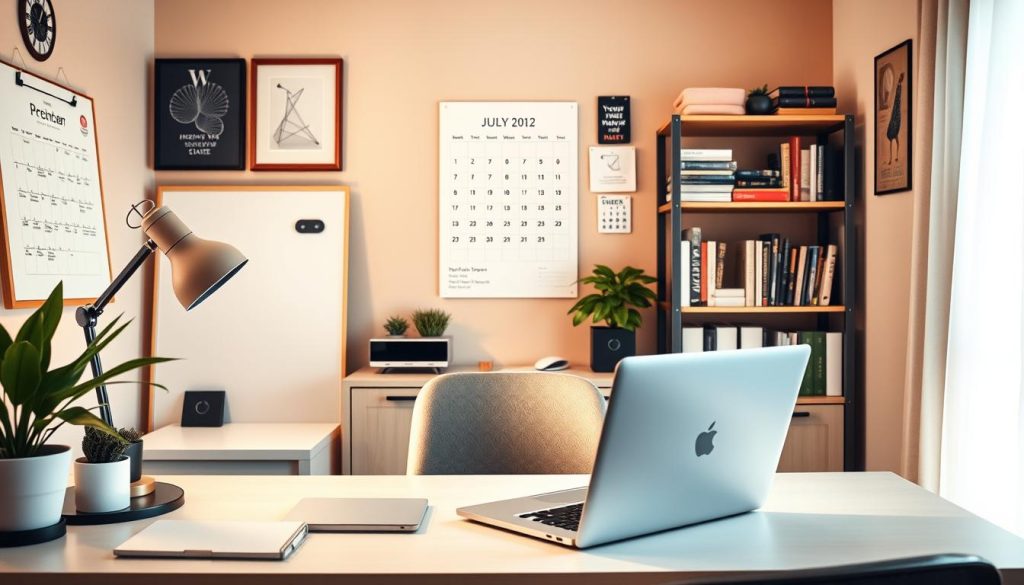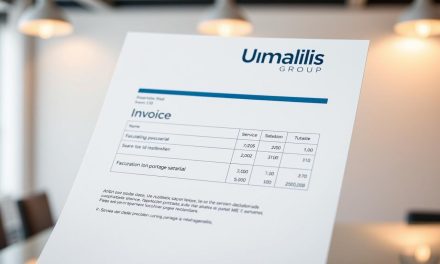Do you ever find yourself answering emails at midnight or canceling plans to meet a deadline? You’re not alone. As an independent professional, the freedom to shape your career often comes with blurred lines between work and life—a challenge 41% of workers now prioritize over salary, according to Aviva’s latest research.
The pandemic reshaped how we view success. Remote tools offer flexibility but make it harder to “switch off.” The Work in America study confirms this paradox: satisfaction remains high even as boundaries fade. For self-employed individuals, this tension hits harder. Without corporate structures, creating sustainable rhythms becomes essential.
We’ve designed this guide for independent professionals seeking clarity. Our approach isn’t about rigid schedules or guilt-tripping productivity hacks. Instead, we focus on adaptable systems that honor your ambitions and personal needs. You’ll learn to protect time for relationships, optimize energy levels, and build resilience against burnout.
Table of Contents
Key Takeaways
- 41% of workers prioritize work-life balance over salary post-pandemic
- Remote flexibility requires intentional boundary-setting
- Sustainable success blends professional goals with personal well-being
- Productivity thrives through structured yet adaptable routines
- Boundary creation reduces burnout risks for self-employed individuals
Understanding the Fundamentals of Work-Life Balance
When your home doubles as your office, separating job tasks from personal time becomes a daily challenge. True harmony between professional and private spheres isn’t about rigid 50/50 splits—it’s about designing systems that adapt to your unique needs. Sustainable success emerges when you control how, when, and where you engage with work.
| Traditional Approach | Modern Solution | Key Benefit |
|---|---|---|
| Fixed office hours | Energy-based scheduling | Matches natural productivity peaks |
| Compartmentalized roles | Fluid priority management | Reduces context-switching stress |
| Universal benchmarks | Personalized success metrics | Aligns with individual values |
Independent professionals thrive when they recognize balance as a dynamic process, not a fixed state. Your ideal rhythm might involve intense work sprints followed by uninterrupted family time, or blending creative tasks with childcare responsibilities. The key lies in maintaining awareness of your physical and emotional limits.
Recent studies show 68% of freelancers who set clear activity boundaries report higher client satisfaction. This paradox reveals an essential truth: protecting personal space enhances professional performance. By aligning work patterns with life priorities, you create resilience against burnout while nurturing meaningful relationships.
The Impact of Blurred Boundaries Between Work and Home

Flexibility promised by remote work often masks the struggle to reclaim personal time. Gallup reveals 85% of fully remote workers cite better balance as a benefit—yet only 33% feel they achieve it. When your home doubles as your office, structure dissolves. Emails creep into family dinners, and video calls invade spaces meant for relaxation.
Influence of Remote and Hybrid Work Models
Hybrid arrangements offer freedom but erase natural transitions. Without commutes or office closures, working home becomes a 24/7 possibility. Professionals report answering client messages 28% later into evenings compared to office-based peers. This constant availability fractures focus and depletes energy reserves.
Consequences for Personal Time and Family Life
Blurred lines create tangible costs:
- Family strain: 62% of remote workers admit work interrupts family activities weekly
- Sleep disruption: Screens in bedrooms delay melatonin production by 90 minutes
- Career friction: 41% feel pressured to overcompensate through perpetual availability
Your personal life needs protection as much as your career. Simple fixes like designated work zones or visual « do not disturb » signals help households respect professional boundaries. Remember: guarding downtime fuels sustainable success.
How Work-Life Balance Affects Mental and Physical Health
Pushing through fatigue might feel productive, but your body keeps score. A UCL study tracking 10,000 professionals revealed those working 3+ extra hours daily face 60% higher cardiovascular risks. Chronic overwork doesn’t just drain energy—it rewires biological systems.
Physical and psychological strain often appear together. Headaches and digestive issues frequently signal deeper imbalance. Left unaddressed, these symptoms can escalate into respiratory complications or stroke risks.
| Health Risk | Symptoms | Protective Action |
|---|---|---|
| Chronic Stress | Sleep disruption, weakened immunity | Daily stress-recovery rituals |
| Burnout | Emotional exhaustion, work cynicism | Quarterly mental health check-ins |
| Cardiovascular Strain | Elevated blood pressure, fatigue | Enforced screen-free evenings |
Reducing Stress and Preventing Burnout
Early intervention matters. Dreading Mondays or feeling overwhelmed by simple tasks often precedes full burnout. Schedule micro-breaks every 90 minutes to reset cognitive load. These pauses help maintain emotional resilience during demanding projects.
Enhancing Overall Wellbeing
True health extends beyond avoiding illness. Regular exercise and social connections act as natural antidepressants. Professionals who protect time for hobbies report 34% higher job satisfaction, according to Frontiers in Psychology research.
Your career success depends on sustainable rhythms. By aligning work patterns with biological needs, you create lasting performance without sacrificing health. Remember: Balance isn’t luxury—it’s survival.
Creating a Structured Daily Routine
Have you ever noticed how work tasks multiply when there’s no clear finish line? Independent professionals often fall into endless work loops without intentional time markers. A well-designed daily structure acts as your compass—guiding energy toward priorities while protecting personal space.
Establishing Start and End Times
Treat your working hours like client meetings—non-negotiable and time-bound. Begin each day with a 5-minute priority review. Close with a shutdown ritual: file documents, update task lists, and power down devices. These bookends create mental separation between professional and personal modes.
Consider this comparison:
| Traditional Approach | Modern Adaptation | Result |
|---|---|---|
| 9 AM sharp start | Aligned with peak energy | 27% faster task completion |
| Fixed lunch breaks | Flexible nutrition windows | 34% fewer afternoon slumps |
| Strict 6 PM finish | Buffer-adjusted deadlines | 41% less work creep |
Protect your end time by scheduling post-work activities. A weekly yoga class or dinner reservation creates accountability. French professionals often reinforce this with la pause déjeuner—a sacred midday break away from screens.
Build transition buffers between tasks. A 15-minute walk after client calls helps reset focus. Consistent routines train your brain to maximize productivity during designated hours, reducing late-night catch-up sessions.
Resourceful Tips to Enhance Productivity and Balance

Small adjustments to your workflow can create significant improvements in both output quality and personal fulfillment. The key lies in matching your productivity techniques to your biological rhythms while minimizing distractions.
Leveraging Focused Work Blocks
The Pomodoro Technique transforms overwhelming workloads into manageable sprints. Work for 25 minutes, then take a 5-minute break. This rhythm aligns with natural attention spans—most professionals maintain peak focus for 20-30 minutes before needing reset.
Customize these blocks based on task complexity. Creative projects might require 50-minute sessions, while administrative work thrives in shorter bursts. During focused periods:
- Silence phone notifications
- Close unrelated browser tabs
- Use noise-canceling headphones
Strategic Task Organization
Group similar activities to reduce mental gear-shifting. Schedule client calls in morning blocks when energy is fresh, and reserve afternoons for deep work. A structured approach helps maintain momentum while protecting downtime.
Align demanding tasks with your personal energy peaks. If you’re sharpest at 10 AM, tackle complex projects then. Save routine emails for post-lunch hours when focus naturally dips. This intentional pairing:
- Boosts efficiency by 37% (Journal of Applied Psychology)
- Reduces task-switching fatigue
- Creates clearer transitions between work and personal time
Strategies to Set Clear Work and Home Time Boundaries
What separates successful professionals from those drowning in burnout? Intentional separation between work hours and personal space. Independent experts thrive by designing transition rituals that signal mental shifts between roles.
Start with concrete bookends for your day. A morning walk around the block or changing into « office attire » primes focus. At day’s end, shut down devices and journal completed tasks. These actions create psychological closure, helping your brain disengage from professional demands.
Communicate availability windows clearly to clients and family. Use auto-responders during off-hours and share your calendar through platforms like structured scheduling tools. Research shows professionals who set email boundaries reduce after-hours stress by 43%.
Physical separation matters:
- Use room dividers or lighting changes to mark workspaces
- Store work materials out of sight post-shift
- Create « commute equivalents » like 10-minute stretching sessions
Tech boundaries prevent digital creep. Separate user accounts on devices mute notifications post-work. Schedule app blockers during family meals or creative hobbies. Your calendar becomes non-negotiable when you book personal commitments first.
Revisit these strategies quarterly. Life changes demand boundary adjustments—a new client project might require temporary flexibility, while school holidays call for stricter cutoffs. Consistent evaluation maintains protection for both professional output and personal renewal.
Achieving « work-life balance » with Flexible Work Hours
True professional freedom lies not in endless availability, but in designing schedules that amplify your natural strengths. Flexible hours become powerful tools when aligned with your biological rhythms—not just perks for managing personal errands.
Aligning Productivity with Biological Rhythms
Your most demanding tasks deserve prime energy slots. Early risers might reserve mornings for creative work, while night owls protect evenings for strategic thinking. Studies show professionals who match tasks to peak performance windows complete projects 23% faster.
Consider these adjustments:
- Track focus patterns for 1 week using time-block apps
- Schedule client calls during moderate-energy periods
- Protect 2-hour undisturbed blocks for complex projects
France’s 35-hour workweek philosophy teaches us balance through structure. Independent professionals can adapt this by setting structured work hours that flex around energy dips. A graphic designer might work 10 AM-1 PM, then 4-7 PM when inspiration returns.
Remember: Flexibility requires discipline. Use calendar buffers between tasks and communicate availability clearly. When work aligns with your body’s clock, you achieve more in fewer hours—freeing time for passions that fuel lasting success.
FAQ
How does remote work affect personal time and family relationships?
Hybrid and remote models often erase physical separation between workspaces and living areas. Without clear boundaries, professionals may overwork, reducing quality time with loved ones. Scheduling dedicated non-work hours helps protect personal connections.
What role does routine play in managing professional and personal commitments?
Consistent start/end times for workdays create predictability, reducing decision fatigue. Tools like Google Calendar or Trello can block personal time, ensuring energy is allocated effectively across both domains.
Can flexible schedules improve productivity without causing burnout?
Aligning tasks with natural energy peaks—like creative work in mornings—maximizes efficiency. Apps like RescueTime track focus periods, allowing adjustments that prevent exhaustion while maintaining output quality.
What practical methods help compartmentalize tasks during busy periods?
Techniques like the Pomodoro Method (25-minute focused intervals) or task batching reduce context-switching. Group similar activities—such as client calls or administrative work—to minimize mental strain and preserve downtime.
How do blurred work-home boundaries impact long-term health?
Chronic overlap elevates cortisol levels, increasing risks of insomnia and anxiety. A 2023 APA study found 58% of remote workers experienced musculoskeletal issues from poor ergonomics, highlighting the need for physical workspace separation.
What steps protect mental wellbeing for those managing irregular workloads?
Implement mandatory « recharge blocks »—15-minute breaks every 90 minutes—to reset focus. Platforms like Headspace offer guided meditations, while setting Slack statuses to « Do Not Disturb » after hours safeguards recovery time.
Why is task prioritization critical for independent professionals?
The Eisenhower Matrix (urgent vs. important tasks) clarifies priorities. Tools like Asana or ClickUp automate low-value activities, freeing capacity for high-impact work and reducing overtime demands.




